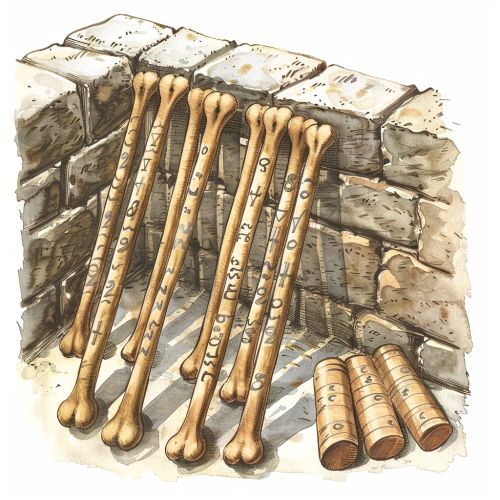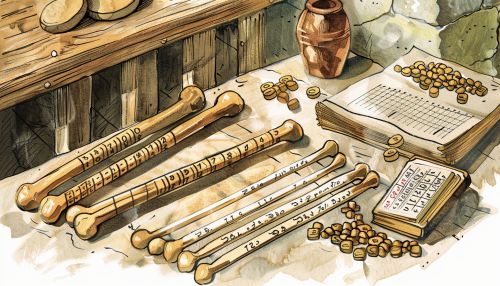Napier's bones
Introduction


Napier's bones, also known as Napier's rods, are a manually-operated calculating device created by John Napier, a Scottish mathematician, in the early 17th century. They are a set of numbered rods, which can be used to perform multiplication and division, as well as to extract square roots. This invention was a significant step forward in the history of computation, preceding the development of the slide rule and mechanical calculators.
Historical Context
John Napier (1550-1617) is best known for his discovery of logarithms, but his invention of Napier's bones also had a profound impact on the field of mathematics. The bones were introduced in his book "Rabdologiae," published in 1617, the same year as his death. This period was marked by significant advancements in mathematics and science, with the Renaissance fostering a renewed interest in classical knowledge and the development of new techniques.
Design and Construction
Napier's bones consist of a set of rectangular rods, each divided into nine squares. Each square contains a digit, and the rods are arranged in such a way that they can be used to perform arithmetic operations. The rods are typically made of wood, bone, or ivory, and are inscribed with numbers in a specific pattern.
The rods are arranged in a grid, with each rod representing a digit from 0 to 9. The digits are arranged in a diagonal pattern, with the product of the digit and the number at the top of the rod displayed in each square. For example, the rod for the digit 2 would have the numbers 2, 4, 6, 8, 10, 12, 14, 16, and 18 arranged diagonally.
Operation
Multiplication
To perform multiplication using Napier's bones, the user selects the rods corresponding to the digits of the multiplier and aligns them next to each other. The multiplicand is then placed at the top of the grid, and the user reads off the products from the rods. The results are then summed to obtain the final product.
For example, to multiply 234 by 5, the user would select the rods for 2, 3, and 4, and align them next to each other. The multiplicand 5 is placed at the top, and the user reads off the products from the rods: 10, 15, and 20. These results are then summed to obtain the final product: 1170.
Division
Division using Napier's bones is a more complex process, but it follows a similar principle. The user selects the rods corresponding to the digits of the divisor and aligns them next to each other. The dividend is then placed at the top of the grid, and the user reads off the quotients from the rods. The results are then summed to obtain the final quotient.
Square Roots
Napier's bones can also be used to extract square roots, although this process is more complex and requires additional steps. The user selects the rods corresponding to the digits of the number whose square root is to be extracted and aligns them next to each other. The user then reads off the square roots from the rods, using a process similar to long division.
Mathematical Significance
Napier's bones represent an important development in the history of mathematics, as they provided a simple and effective method for performing arithmetic operations. They were widely used in Europe during the 17th and 18th centuries and were an important precursor to the development of more advanced calculating devices, such as the slide rule and mechanical calculators.
The invention of Napier's bones also contributed to the development of logarithms, as they provided a practical method for performing multiplication and division. This, in turn, facilitated the development of more advanced mathematical techniques and the growth of the field of mathematics as a whole.
Legacy and Influence
Napier's bones had a lasting impact on the field of mathematics and computation. They were widely used in Europe during the 17th and 18th centuries and were an important precursor to the development of more advanced calculating devices. The principles underlying Napier's bones were later incorporated into the design of the slide rule, which became a standard tool for engineers and scientists until the advent of electronic calculators in the 20th century.
The invention of Napier's bones also influenced the development of mechanical calculators, such as the Pascaline and the Leibniz wheel. These devices built upon the principles of Napier's bones and provided more advanced methods for performing arithmetic operations.
Conclusion
Napier's bones represent a significant milestone in the history of mathematics and computation. They provided a simple and effective method for performing arithmetic operations and laid the groundwork for the development of more advanced calculating devices. The legacy of Napier's bones can be seen in the development of the slide rule and mechanical calculators, as well as in the continued growth of the field of mathematics.
